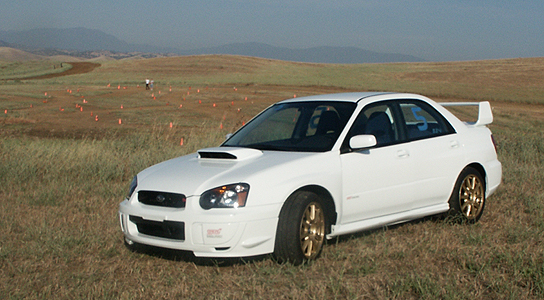
(above - 2005 STI near Willows, CA)
Let’s cut to the chase. All of these road-going rally cars are really quick for the money, and generally fun to drive both on and off of the pavement, but surprisingly each version has a distinct personality when pushed towards the limits of adhesion. A big portion of the character of these cars depends greatly on one complex piece of equipment – the center differential and how it apportions torque around the car for changing grip conditions. Everyone I talked to about the 2004 STi seemed to be in general agreement that the way it distributed torque made it a little too front biased – or understeery. For 2005 the factory played with the Driver Controlled Center Differential (DCCD) and allowed for a more rear-biased torque split of 35/65% front/rear. Keep in mind all of the versions will throw 50% of torque at the front wheels in the locked settings, or as needed when grip is low and the center diff is set in the automatic settings.
So on the road, with the diff settings all the way back, the 2005 STi behaves more like a rear drive car and rotates the rear end more generously than subsequent versions. The center differential was an electronically controlled unit – taking data from yaw sensors and wheel speed to calculate the variable torque distribution (when not locked) and wasn’t totally without fault. When driving the 2005 STi in quick back and forth switchbacks – throwing its weight quickly from side to side, as the car transferred weight, I experienced a rubbery feel as the car changed the torque distribution based on the yaw sensor and grip level at each wheel. It was like the torque delivery was a fraction of a second behind, and as a result the car felt like, just for an instant, the tires were under-inflated and it would move on the sidewalls. As soon as the torque split adjusted itself as the car loaded up, it felt normal again. At the time I didn’t realize what was happening exactly, but knew that it felt odd for a split second in that no-mans-land while the weight transferred from side to side on grippy surfaces. Most cornering didn’t bring out the trait.
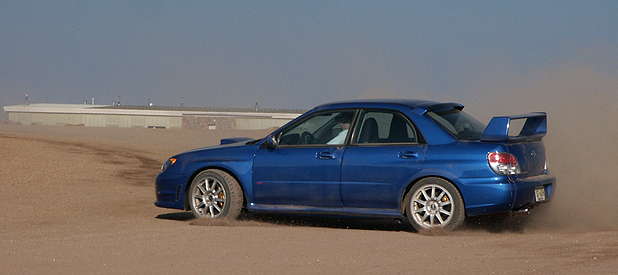
(above, 2006 STI on Pikes Peak)
Later on, (at the launch of the 06 car) I talked with Subaru’s engineers about the phenomenon, and they explained that there was a slight lag in the impulses sent to the electronically controlled center diff that distributed the torque. This prompted the change from the electronically activated unit to a mechanical center diff for 2006, with revised torque splits. In aggressive driving, the mechanical diff did the trick to eliminate the weird delay, but two more center diff changes for 06 slightly mellowed the STI’s character. Torque splits front/rear were also moved forward a bit to 41/59, and a new steering sensor added steering data to the mix of information used to distribute the torque.


Heading down Pikes Peak in the '06
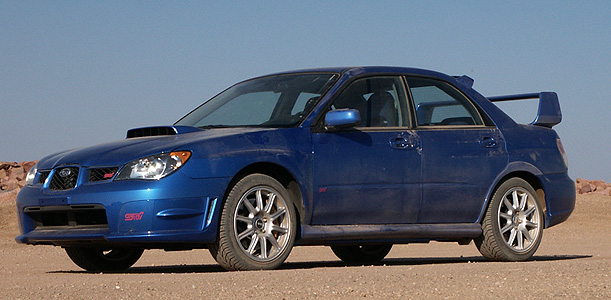
When the pavement ends, the steering sensor really comes into play. On the ‘05 version the throttle could be used to kick the car around sideways, then the yaw sensor would yell at the computer to throw the power to the front – making dramatic power slides look easy. The 2006 STI knows which way your wheels are pointed, the forward transfer of power happens sooner, and it squares itself up from a slide more quickly. So for dramatic looking drifts, you’ve got to rotate the car as it enters the corner by trailing off the throttle and allowing it to rotate – then apply the throttle and let it claw its way out. Off road, you should be doing this anyway – but I felt a little more comfortable pushing the 06 STI harder on the loose stuff.

2008 STI
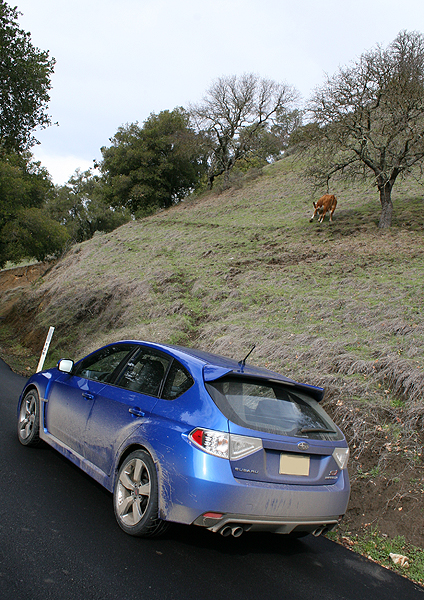
2008 STI
For 2008, the STI was redesigned as a five-door hatch. It looks and feels bigger, and from the outside in base trim, the wheels evoke a Pontiac Vibe feel at first glance. (To get the cool gold rally-look spoke wheels you’ve got to order the navigation package, putting your 35k STI dangerously close to the $40k mark.) The platform is softer, and has more body roll than the ’05 or ’06. On the pavement, the best cornering feel (pulling the car out of understeer most rapidly) is achieved with the center diff set in one of two auto settings, and even when the torque bias is set (manually) rearward I encountered lots of mid- corner understeer. I’ve read that the manual setting will deliver up to 25/75% torque front/rear, but the softer platform keeps it from feeling that way. The one time I was able to rotate it on-throttle from a stop, when the body roll maxed out, the car shot forward, where you could continue to drift in the previous versions. Quicker? Perhaps, but for me the setup compromised the “fun” factor. The additional body roll and softer shock bump may ultimately give the car more grip, but it loses a bit of that tossable feel during quick direction changes too. Off the road, it’s the most capable of the three in terms of covering ground quickly, and posts slightly better acceleration and slalom numbers than its predecessors.
In the end, I had the most fun with the ’05 STi, despite any time lag from the electronic diff for its willingness to slide, hang there for a bit, then claw itself out. Plus I think the grill and front-end treatment is the easiest of all of them on the eyes. All three have the same torque related issues with the front differential, making the car turn into a corner slightly differently on and off throttle – if razor sharp steering is your biggest hangup, the Lancer Evo has a leg up in that department. If ride quality is an issue, the newest version is the most refined of the bunch.
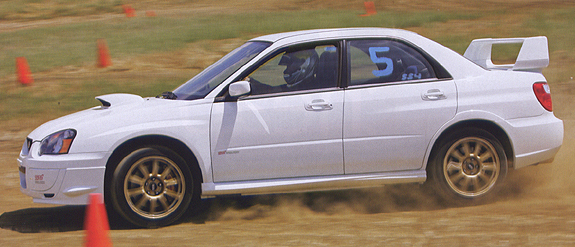
2005 STi
3 comments:
Great article! I thought the 2004 STi also had a 35/65 torque split, but the difference in handling is due to the change in caster (2005 and on have a slightly longer wheelbase while retaining the stock strut mountin points) and the AP Suretrac front diff, which was replaced with a helical unit for 2005. I have no doubt that your observations are spot-on, but could those be the reasons for the pushiness of the 04 model?
yes- What a great article.
I am close to 50 years old and have had a subaru WRX/STi as company cars for the past 10 years. (one every year in fact...very lucky to have a boss who looks after me!)
I live in the Mountains in Australia.. Twisty foggy with broken tar and dirt. The Subaru is the best product for this sort of terrain.
However, I jumped into the current series
( a hatch) and after one week promptly handed it back. It was too soft, understeered like mad, felt "fat", more like a liberty. I had no confidence on our mountain raods in it as it understeered in the wet...
I found the last of the "old" 06 2.5 litre, bought it and am deltighted with it.
I agree that the 05 is the "pick" but the 06 is more forgiving in peak hour traffic eg if you are in the wrong gear, yet still gives you all the perfomance.
What to replace it with?
Well.... the Evo 10 looks like it runs rings around the current StI, and sadly, after 10 years, of enjoying Subaru I may shift to the opposition....
i did. never looked backed.
-08' evo x
Post a Comment